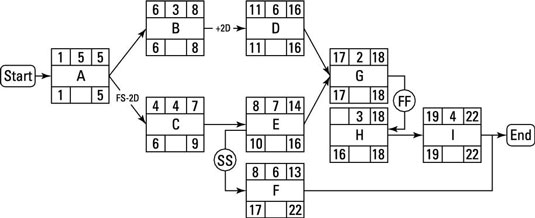You will need to become familiar with conducting a backward pass for the PMP Certification Exam. The backward pass tells you the latest time activities can start and finish without violating a schedule constraint (such as a mandatory milestone) or without causing the project to be late.
If you have a hard schedule constraint, such as a mandatory review date or a contractually required delivery date, you can enter that as the late finish date. This might cause a situation called negative float.
For a backward pass, follow these steps:
Take the early finish date of the last activity in the network and enter that number as the late finish date as well.
Therefore, your early finish and late finish for the last activity will be the same. For this example, it’s 22 days.
Subtract the duration and add 1 to establish the late start for the last activity in the project.
Because you start the project at Day 1, instead of Day 0, you need to add the 1 day back in to get accurate dates.
Using the late start date, subtract 1 to derive the late finish date for any immediately preceding activities.
This example has two final activities: Activity I and Activity F. You would use the highest number as the late finish date. Activity I finishes on Day 22, and Activity F finishes on Day 13.
Therefore, the late finish for the project is Day 22. For Activity I, you subtract the duration of 4, add 1 and get a late start of 17. Day 17 is the latest date when Activity I can start and not cause the project to be late. For activity H the late start date minus 1 carries backward to become the late finish for Activity H.

Note these areas:
Activity H does not have an early start, but it does have a late start because in this scenario, you’re not so worried about when Activity H can start. Rather, you’re more concerned about when it finishes. In a real-life scenario, you would have more information about the nature of the activity in the activity attributes. That would give you insight into when Activity H would need to start.
The late start of Activity D is 11, but the late finish of its predecessor (Activity B) is not 10, but 8, because there is a two-day lag. You treat that lag as if it were a mini-activity called “don’t do any work here.” Therefore, calculate the late start of B as 10, and you subtract 2 to get a late finish of 8 for Activity B.
The relationship between Activity E and Activity F is start-to-start. It would seem that the late start of Activity F would drive the late start of Activity E. However, in this case, the late start of Activity G drives the late finish of Activity E, which in turn determines the late start. This demonstrates an important rule in the backward pass:
When you have two possible options for a late start or finish, the lowest one is the one you select.

